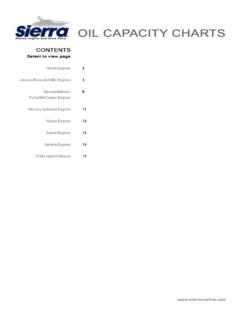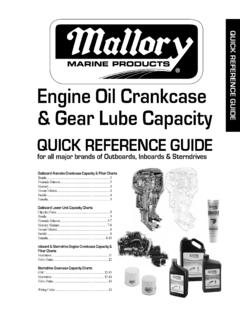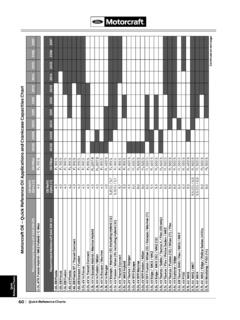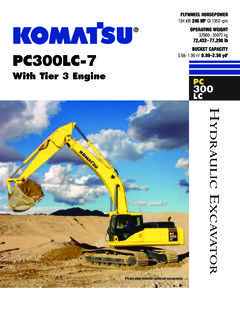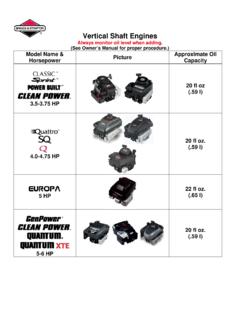Transcription of Appendix 6 Oil and Diesel Storage - SSC Group
1 SRC Sheepmoor North Prospecting Right Application Environmental Management Plan March 2010 Appendix 6 ENVIRONMENTAL PROCEDURE: OIL AND Diesel Storage Issue date: March 2010 page 2 of 4 EP-001 ENVIRONMENTAL PROCEDURE: OIL AND Diesel Storage 1 PURPOSE This procedure is intended to reduce pollution caused by inadequate Storage of oil and Diesel in above ground drums and tanks. 2 ACTIVITIES AFFECTED All SRC prospecting activities, including sub-contractor yards and rented workshops. 3 MANAGEMENT PLANS TO BE USED WITH THIS PROCEDURE Environmental Incident Report Sheet, where spills have occurred. Checklist for oil and Diesel Storage tanks for checking and corrective action. 4 DEFINITIONS Impermeable surface: means that a liquid cannot seep through the surface and contaminate underlying soil and water.
2 A cement or concrete paved area is an example. Secondary containment: is a mechanism like a bund or drip tray designed to prevent oil and Diesel from escaping to the environment in the event of leakage from the drum or ancillary equipment like taps, draw-off pipes, etc. 5 EXCLUSIONS None 6 PROCEDURE Oil and Diesel Storage Oil and Diesel must be stored in a container of sufficient strength and structural integrity to ensure that it is unlikely to burst or leak during ordinary use. Safety, security, access and maintenance needs must be considered when storing oil and Diesel . Do not store oil and Diesel in significant risk locations, near streams, boreholes or fire hazards. Avoid storing oil and Diesel above roof level. The surface where oil and Diesel is delivered and handled must be impermeable and not connected to surface water drainage systems, including stormwater drains.
3 Full and/or empty oil and drums or other containers may under no circumstances be stored directly on unprotected soil. Oil and Diesel drums should be placed on a suitable stand over a drip tray within a secondary containment area for ease of use and to minimize spillage. Empty oil and Diesel drums must be stored inside the secondary containment for collection, removal off site and disposal to a suitable landfill in the Item or xCommentsAre your oil containers in good condition?If no, address immediatelyIs your oil stored in a secondary containment?If no, see specifications in Section of Oil Management Procedure Does the secondary containment comply with specifications?See Section of Oil Management Procedure for detailsFor a single tank, is the secondary containment at least 110% of the maximum Storage capacity of the drum?
4 See calculation table in Section of Oil Management ProcedureMore than one tank, is the secondary containment at least 110% of the maximum Storage capacity or 25% of the total maximum Storage capacity, which ever is the greatest?See calculation table in Section of Oil Management ProcedureIs the secondary containment system impermeable to oil and water?If no, address immediatelyAre there any holes, pipes or other exits from the secondary containment?If yes, repair to ensure no discharge from the secondary containmentAre oil containers fitted with suitable dispensing mechanisms?If no, refer to Section of the Oil Management ProcedureAre any oil containers stored on unprotected ground?If yes, remove and place inside the secondary containmentAre there any evidence of oil spills?If yes, clean up and dispose of contaminated material in Industrial Waste BinChecklist for oil Storage tanksThis checklist will help you decide wether improvements of your oil Storage facilities is required comply with the Pamodzi Gold Oil Storage and Management Procedure Issue date: March 2010 page 3 of 4 EP-001 ENVIRONMENTAL PROCEDURE: OIL AND Diesel Storage area.
5 It is the responsibility of the Supervisor to manage the disposal of empty oil and Diesel drums. Under no circumstances may empty oil and Diesel drums be dumped outside the secondary containment area. Where possible, store old unusable oil in an oil drum for collection and recycling. These drums must be stored inside the secondary containment area. Secondary containment specifications Situate all oil and Diesel containers and ancillary equipment within a liquid tight secondary containment system like a bund. The risk of oil and Diesel escaping the bund and contaminating the environment will be minimised when the following are adhered to: Keep the primary container as low as possible. Ensure that the walls of the bund are of sufficient height and integrity to avoid leakage.
6 The design specifications for the bund are provided in Section below. Ensure that all oil and Diesel dispensing mechanisms, valves, filters, or other ancillary equipment are kept inside the bunded area to avoid spills outside the secondary containment. Leave sufficient space, a minimum of 750mm between the container and the bund wall, and 600mm between the container and the base of the bunding, to allow access for external inspection. Do not place one container above another. The bunding must be impermeable to liquids. There must be no direct outlet from the bunded area. No pipework may pass through the wall of the bund. The bunded area may not be discharged to any drain, sewer or watercourse or be discharged into the yard or unprotected soil. The bunded area must be roofed to ensure that rainwater does not collect inside the bunded area.
7 Rainwater will reduce the volume inside the bund, making the bunding ineffective. Do not use bunds to store materials or wastes, as this will reduce the capacity. Capacity of the secondary containment/bund The secondary containment system must provide Storage for at least 110% of the capacity of the container stored inside it. If more than one container is stored, the system must be capable of storing 110% of the largest container or 25% of the total container capacity within the bund, whichever is the greatest. When calculating bund capacity, take account of any volume taken up by drum support within the bund. Calculation of capacity for secondary containment systems: Maximum capacity of containers to be stored .. litres (A) Containment capacity = length x width x depth.
8 M3 Then multiply capacity by 1000 to convert to litres .. litres (B) Volume lost due to tank supports (if significant) .. m3 Then multiply volume lost by 1000 to convert to litres .. litres (C) Actual containment capacity = B C .. litres (D) (C=0, if tank support volume is not significant) Minimum containment capacity = 110/100 x A .. litres (E) If D is equal or greater than E, then the containment system volume is adequate and will comply with specifications. If D is less than E, the containment capacity is insufficient and must be rectified to comply with specifications. Issue date: March 2010 page 4 of 4 EP-001 ENVIRONMENTAL PROCEDURE: OIL AND Diesel Storage Deliveries and dispensing Supervise all deliveries to help avoid spillages, prevent damage to the environment and save valuable raw materials.
9 Ensure that the secondary containment area is of sufficient size and volume to store all oil or Diesel received within the bunded area. No oil or Diesel may be stored outside the bunded area. Suitable oil and Diesel dispensing mechanisms like pumps or taps must be fitted to containers to prevent spillage. Under no circumstances may oil drums be tipped over to pour oil out. General maintenance Inspect all bunds, tanks and pipework regularly for signs of damage, at least weekly. To ensure that the bund retains its integrity, repair any defects in the bund wall promptly. Deal with damage to oil drums or Diesel containers immediately. Any accumulated oil, Diesel , debris or sand must be removed and disposed of in an appropriate manner to a suitable landfill site. Do not cover the base of the secondary containment area with sand or any other material.
10 This will hide oil or Diesel spills and make inspections difficult. Ensure that drip trays are in place when using oil outside the secondary containment area. Do not undertake any maintenance work involving oil or Diesel on unprotected soil, always use a drip tray to contain any spillages. Dealing with spills It is SRC s priority to undertake all measures to prevent spills , to ensure that oil and Diesel is stored and dispensed according to the specifications discussed above and to use drip trays when working with oil and/or Diesel . In the event of a spill, keep a stock of absorbent materials like sand or commercial products on site to deal with spillages and train staff in their use. Make use of spill kits. Ensure that relevant staff is training to use spill kits effectively.
